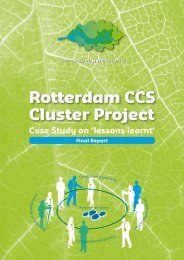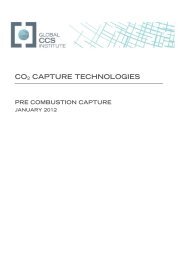Perceptions of CO2 Report - Global CCS Institute
Perceptions of CO2 Report - Global CCS Institute
Perceptions of CO2 Report - Global CCS Institute
- No tags were found...
You also want an ePaper? Increase the reach of your titles
YUMPU automatically turns print PDFs into web optimized ePapers that Google loves.
Univ_dmy - - - - -Female_dmy - - - - -U20s_dmy -0.044* - - -0.046* -0.036*Demogr a30s_dmy - - - - -aphics a40s_dmy - - - - -a50s_dmy - - - - -O60s_dmy - - - - -Csea_dmy - - - - -Adjusted R-squared 0.241 0.259 0.179 0.200 0.343Note) *: significant level below 5%, **: significant level below 1%(MC): the covariate is excluded from the regression analysis because <strong>of</strong> high multicollinearity with other covariate (VIF is higherthan 10)The table above shows to what extent the used knowledge items explain the respondent’s answerto each <strong>of</strong> the four perception items. Each column represents one <strong>of</strong> the perception items. The firstone is the negative-positive scale, the second the dirty-clean scale, the third the useless-usefulscale, and last column is the dangerous-safe scale. The explanatory values <strong>of</strong> the measuredknowledge items vary between adj. R 2 = .18 and adj. R 2 = .26, which are all fairly low. This meansfor example that 24% <strong>of</strong> the variance <strong>of</strong> answers people give on the negative-positive scale areexplained by the knowledge items in the survey. The other 76% is explained by factors notmeasured in this part <strong>of</strong> the survey. For a summary <strong>of</strong> results, see report body text.70 | Understanding how individuals perceive carbon dioxide
















